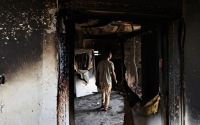5 December 2007PlanetArk
The United Nations hopes the Bali gathering will launch a two-year dialogue that will lead to a replacement of Kyoto or an expanded version of the pact.
Here is a guide to some of the issues on the table at Bali.
* TIGHTENING THE TARGETS:
-- Greenhouse gas emissions have continued to rise despite countries' attempts to meet their Kyoto targets. And current Kyoto targets have been criticised as being too-little too-late.
-- The United Nations' Intergovernmental Panel on Climate Change, in its latest scientific reports, says it is very likely the rapid rise in greenhouse emissions above natural levels is due to mankind's burning of fossil fuels, deforestation and agricultural practices. The European Union says an average temperature increase of no more than two degrees Celsius above pre-industrial levels should be considered the limit. Beyond this, the world is at risk from dangerous climate change, it says.
* BRINGING IN DEVELOPING COUNTRIES:
-- Drawing in developing countries excluded from Kyoto's first round, such as China, the world's second biggest carbon emitter, will be crucial if the new agreement is to avoid criticisms of inequity that have dogged Kyoto. The Bush administration pulled out of Kyoto saying it unfairly penalised its economy but is now under pressure to do more to rein in its own emissions.
* CARBON FORESTRY:
-- More carbon is emitted from deforestation than the global transport sector, but forests are not factored into Kyoto.
-- For the past few years forest-rich developing countries such as Indonesia have been lobbying to monetise the "avoided carbon emissions" their forest carbon stores represent.
-- Paying poor countries to protect mature trees prevents carbon emissions while offsetting the financial losses involved in passing up lucrative forest clearances for timber and plantation concessions, supporters of schemes such as Reduced Emissions from Deforestation in Developing Countries (REDD) say.
* TECHNOLOGY TRANSFERS:
-- Combatting climate change through the use of cleaner, more energy-efficient technologies has high-level backers on both sides of the rich-poor divide that has threatened to derail global responses to climate change.
-- In May, an IPCC report said US$20 trillion must be spent by 2030 on upgrading the world's energy infrastructure to reduce emissions.
-- While many are keen to push for such transfers, Kyoto's subsidised technology transfers from developed to developing world, via the Clean Development Mechanism, have attracted criticism for focusing especially on a narrow range of lucrative projects in China, and elsewhere for delivering emissions cuts against rather hypothetical baselines.
* ROPING IN OTHER POLLUTION SOURCES:
-- Kyoto's first phase, which ends in 2012, focuses mainly on controlling pollution from industrial sources.
-- At Bali, British and European negotiators are expected to push for emissions from the global aviation and shipping industries to be included in a successor pact. They argue fast-rising emissions from these sectors could cancel out savings made elsewhere if they are not addressed.
Sources: Reuters
-- For Reuters latest environment blogs go to: http://blogs.reuters.com/environment/
(Writing by Gill Murdoch, Singapore Editorial Reference Unit, editing by David Fogarty)






